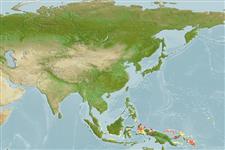>
Gobiiformes (Gobies) >
Gobiidae (Gobies) > Gobiinae
Etymology: Trimma: Greek, trimma, -atos = something crushed (Ref. 45335); aturirii: Named for Abraham Aturiri, Governor of West Papua province (2006-2016)..
Environment: milieu / climate zone / depth range / distribution range
Ecología
marino asociado a arrecife; rango de profundidad 38 - 70 m (Ref. 102609). Tropical
Western Pacific: Indonesia, West Papua.
Tamaño / Peso / Age
Maturity: Lm ? range ? - ? cm
Max length : 1.9 cm SL macho / no sexado; (Ref. 102609)
Short description
Morfología | Morfometría
Espinas dorsales (total): 7; Radios blandos dorsales (total): 9-10; Espinas anales 1; Radios blandos anales: 9 - 10. This species is unique in the having the following characters: 2 dark oblique stripes on either side of the pupil (blue, edged with red in life, dark brown in preservative), the lower one continues posteriorly across the dorsal margin of the opercle; bipartite colour pattern - dorsal half of the body red or orange, ventral half abruptly white or pale pink in life; with a narrow bony interorbital (?50 % pupil width), a moderate interorbital trench with a slight groove posterodorsal to the eye; cheek, opercle and predorsal midline are scaleless; without elongate spines in the first dorsal fin; D2 I,9-10; A 9; pectoral fin rays 17-18 (7-11 are branched); an unbranched fifth pelvic fin ray (Ref. 102609).
Often found perched individually on vertical surfaces at the back of crevices and overhangs. Collected with clove oil from exposed oceanic atoll with clear water, steep outer wall with small crevices and overhangs, coarse white coralline sand (38 m) and steep outer reef slope with white calcareous sand (40 m); the holotype from steep wall covered with coarse white Halimeda sand (60 m) (Ref. 102609).
Life cycle and mating behavior
Madurez | Reproducción | Puesta | Huevos | Fecundidad | Larva
Winterbottom, R., M.V. Erdmann and N.K.D. Cahyani, 2015. New species of Trimma (Actinopterygii, Gobiidae) from Indonesia, with comments on head papillae nomenclature. Zootaxa 3973(2):201-226. (Ref. 102609)
IUCN Red List Status (Ref. 130435)
Threat to humans
Harmless
Human uses
Más información
Nombres comunesSinónimosMetabolismoDespredadoresEcotoxicologíaReproducciónMadurezPuestaAgregación para la puestaFecundidadHuevosEgg development
Age/SizeCrecimientoLength-weightLength-lengthLength-frequenciesMorfometríaMorfologíaLarvaDinámica larvariaReclutamientoAbundanciaBRUVS
ReferenciasAcuiculturaPerfil de acuiculturaRazasGenéticaElectrophoresesheritabilidadEnfermedadesProcesamientoNutrientsMass conversion
ColaboradoresImágenesStamps, Coins Misc.SonidosCiguateraVelocidadTipo de nataciónSuperficie branquialOtolitosCerebrosVisión
Herramientas
Special reports
Download XML
Fuentes de Internet
Estimates based on models
Preferred temperature (Ref.
123201): 27.6 - 28.8, mean 27.8 °C (based on 6 cells).
Phylogenetic diversity index (Ref.
82804): PD
50 = 0.5000 [Uniqueness, from 0.5 = low to 2.0 = high].
Bayesian length-weight: a=0.00708 (0.00333 - 0.01504), b=3.09 (2.92 - 3.26), in cm total length, based on LWR estimates for this (Sub)family-body shape (Ref.
93245).
Resiliencia (Ref.
120179): Alto, población duplicada en un tiempo mínimo inferior a 15 meses (Preliminary K or Fecundity.).
Fishing Vulnerability (Ref.
59153): Low vulnerability (10 of 100).
